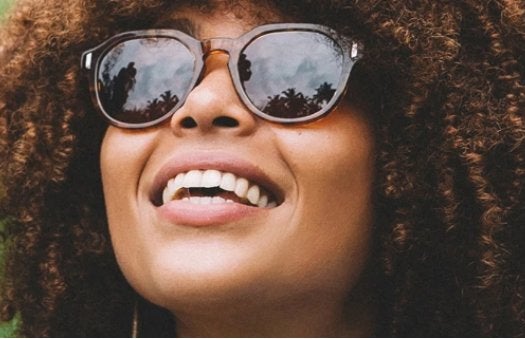Taking care of your hair and trying to keep it healthy is a year-round task, but the dry and cold air can place extra stress on your luscious locks during the winter. Plus, all of that stress is amplified when you have a mane of curls. Your head ends up resembling a nest a lot of the time and feels more like hay than hair considering the fact that you deep conditioned it just 12 hours ago. Consider the following tips to help you maintain your curls and healthy hair even while it’s cold out!
Use the right products
There is a wide variety of curly hair products on the market for every hair type. You can find products that cater to high or low porosity, damaged hair, treated hair, dry hair, oily hair, etc. You can even Google ways to figure out whether or not your hair is porous, dry, and what texture you have (wavy is not curly, curly is not coily) and buy accordingly. For example, I have type 4a curls with low porosity and dry hair/scalp. This tells me that I should wash my hair less than someone with a “looser” hair texture in order to maintain enough moisture, and during winter my hair will be dryer than usual meaning I should provide more moisture to protect it. One example is that my hair isn’t treated, so when looking for products I do not have to look for repairing creams. Instead, what I’d look for is a maximum moisturization cream with natural ingredients (remember chemicals can dry out the hair), mostly naturally oily plants like shea and avocado, or I’d get Jamaican black castor oil products which help maintain thickness and moisture while also stimulating growth. If you don’t have the money or time to go out and shop for hair care, you can make DIY hair masks and creams that will be just as good. There are tons of DIY curly hair product videos on YouTube and articles on google explaining how to’s. The more natural, the better! By the way, you might concern your local grocer only a little while making DIY curly hair products since you’ll walk out with 20 avocados and 5 bottles of olive oil. Your hair will thank you later.
Co-wash instead of shampooing
This may sound gross, but maybe…you should stop using shampoo for a while. I promise you won’t look greasy or smell bad! Just hear me out: shampoo strips the natural oils from your hair. Your hair produces its own healthy oils, but curly hair has a harder time getting that oil down the hair shaft because of all the twists and coils. Shampoos often have harsh chemicals that strip your hair of its natural oils, causing your hair that already has trouble getting oil to be even more dried out! Instead of using shampoos every few days, consider using conditioner if you’re washing your hair multiple times a week in order to restore moisture. I would suggest shampooing at the end of the week to get rid of product build-up if you have type 2-3 curls, and after two weeks if you have type 4 curls.
Stop washing your hair altogether
This piggybacks off of the previous section, so don’t be too quick to judge. Instead of alternating between co-washing and shampooing weekly or bi-weekly, you could just not wash your hair at all. This is much easier for kinky/coil types, but might be challenging for someone with a type 2 wave texture or a loose type 3 curl. Your hair gets visibly greasy, and although your scalp would eventually acclimate to the extra oil, you might not want to go around looking like oil and garlic linguini for months. If you have kinkier hair, you could stick to not washing your hair with any product, and simply using water to rejuvenate your curls and then using leave-in conditioners, hair butters, etc. to lock in moisture. I personally would not recommend this, but it is certainly a choice.
Take advantage of protective styling!
Protective styling is an aspect of having versatile hair that I hold near and dear to my heart. Any time winter rolls around, you can be sure to see me with passion twists or box braids. These styles help lock in moisture, and they are low manipulation so they limit the amount you might be touching or breaking your brittle winter hair. Protective styling helps maintain thickness and length because your hair is being protected by infrequent exposure to chemicals, heat, and even water (depending on the style).
Protective styling differs a bit depending on your hair texture. For waves and loose curls (types 2-3b), I would recommend something simple like a silk/satin headscarf or bandana to keep your hair protected from the air a bit more or a satin-lined hat if you want a warmer option. Satin and silk are both gentle on curls and won’t break or tug your hair like knit and cotton headwear does. You could also opt for french/dutch braids and keep them in days at a time so you don’t have to fuss with your hair every morning. A quick hair cream and braid down before class will keep your hair adequately moisturized for days.
For kinkier curls and coils (types 3c-4c), I would recommend a style that introduces extensions, like box braids or passion twists. Curlier hair needs a bit more moisture and attention, so putting your hair in this style for 4-6 weeks and consistently oiling your scalp and co-washing your roots is a great way to retain moisture and length during the winter months. You could also utilize something simple like a scarf or a Dutch/French braid if you don’t have hours to spend in a hair getting your hair braided/twisted.
These certainly are not all the tips I could give, but curly hair is so versatile and varies from person to person. The best thing you can do for your curls is to research! Find out what your hair and scalp likes, try products to see what does and doesn’t work for you, because maintaining curls is mostly trial and error. Embrace your little shrub!



